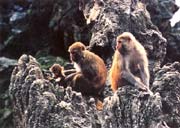|
The rhesus macaque (Macaca mulatto)
 The Rhesus Macaque is mainly distributed in the broadleaved forest, the theropencedrymion, the bamboo forest and bare rocks with sparse trees in the Wolong Natural Reserve. Making its home in caves or cliffs, they may also sleep in the tree at night. A group of rhesus macaques has no certain number, but often 40 to 50 members. With acute hearing and vision, it is also good climber and agile jumper among the trees. It can swim through rivers. At daytime, rhesus macaques often search for food among the trees or frolicking on the ground. Its sundry diet consists of wild fruits, wild vegetables, tender shoots and leaves, blossoms, and bamboo shoots, sometimes even small birds, bird eggs, and insects. At harvest time, they may also take crops for food. The mating season of the macaque is uncertain. After about 150 to 165 days' pregnancy, a pregnant female macaque often gives birth to one cub or two cubs occasionally, mostly in summer. In CHINA'S NATIONAL LIST FOR SPECIALLY PROTECTED WILD ANIMALS, the rhesus macaque was listed in Appendices II as a species threatened with extinction. The Rhesus Macaque is mainly distributed in the broadleaved forest, the theropencedrymion, the bamboo forest and bare rocks with sparse trees in the Wolong Natural Reserve. Making its home in caves or cliffs, they may also sleep in the tree at night. A group of rhesus macaques has no certain number, but often 40 to 50 members. With acute hearing and vision, it is also good climber and agile jumper among the trees. It can swim through rivers. At daytime, rhesus macaques often search for food among the trees or frolicking on the ground. Its sundry diet consists of wild fruits, wild vegetables, tender shoots and leaves, blossoms, and bamboo shoots, sometimes even small birds, bird eggs, and insects. At harvest time, they may also take crops for food. The mating season of the macaque is uncertain. After about 150 to 165 days' pregnancy, a pregnant female macaque often gives birth to one cub or two cubs occasionally, mostly in summer. In CHINA'S NATIONAL LIST FOR SPECIALLY PROTECTED WILD ANIMALS, the rhesus macaque was listed in Appendices II as a species threatened with extinction.
The Sambar (Cervus unicolor)
The Sambar is mainly distributed in the broadleaved forest or coniferous forest with an altitude of 1400 to 3500 meters in the Wolong Natural Reserve. Arboreal in its habits, sambars often hide themselves in the thick woods and sleep at day time. Living solitarily or in pairs, they only form in groups in mating season. Acute and agile, they are good at runners. Its diet consists of green grass and tree leaves. The mating season of the sambar is between April and June. After about six months' pregnancy, a pregnant female sambar often gives birth to one cub. In CHINA'S NATIONAL LIST FOR SPECIALLY PROTECTED WILD ANIMALS, the rhesus macaque was listed in Appendices II as a species threatened with extinction.
The goral (Naemorhedus goral)
The goral is mainly distributed in the bare rocks and mountain cliffs in the Wolong Natural Reserve. Gorals often move about singly or in pairs, but sometimes also in groups of three. Acute both in hearing and seeing, they are agile jumpers and runners. They bleat like goats, but their alarming sound sounds like sharp hissing. Arboreal in its habits, gorals often hide themselves in the thick woods or caves and sleep at day time. In the morning or evening they come out to eat tender leaves and twigs, green grass and mosses. The mating season of the goral is winter. After about six months' pregnancy, a pregnant female goral often gives birth to one cub. An animal peculiar to central Asia, In CHINA'S NATIONAL LIST FOR SPECIALLY PROTECTED WILD ANIMALS, the rhesus macaque was listed in Appendices II as a species threatened with extinction.
The Serow (Capricornis sumatraensis)
The Serow is mainly distributed in the bare rocks, mountain cliffs, and shrubberies in river valleys in the Southeast mountains and the edge of the Sichuan Basin. Serows are good jumpers between the cliffs. A tough animal though, they are acute and agile runners. Arboreal in its habits, serows often hide themselves at day time, but move about singly or in pairs, but sometimes also in groups of three in the morning or evening. Their favorite diet consists of mushrooms, tender leaves, and twigs. The mating season of the serow lasts from late September to October. After eight months' pregnancy, a pregnant female Srow often gives birth to one cub. An animal peculiar to Southeast Asia, In CHINA'S NATIONAL LIST FOR SPECIALLY PROTECTED WILD ANIMALS, the rhesus macaque was listed in Appendices I as a species threatened with extinction.
The Burhel (Capricornis sumatraensis)
The Burhel is mainly distributed in the broadleaved forest as well as the theropencedrymion in the Wolong Natural Reserve. However, it rarely appears in the artificial forest. Timid in natura, burhels are good tree climbers and jumpers. They are solitary animals that only move about in the morning and evening. The route a burhel follows is relatively fixed, because they make marks with tailbone gland oil on stumps and rocks. The burhel is also a clean animal that often covers its dung with forefeet. Its diet consists of mosses, lichen, and grass. The mating season is winter and a pregnant female burhel often gives birth to two cubs in June of the following year. An animal peculiar to Southeast Asia, In CHINA'S NATIONAL LIST FOR SPECIALLY PROTECTED WILD ANIMALS, the rhesus macaque was listed in Appendices II as a species threatened with extinction
Takin.snow leopard.Neofelis nebulosa.Leopard.The Tibetan macaque
The Alpine Musk Deer.The Large Indian Civet.The Small Indian Civet.The Golden Cat.The Lynx
|



